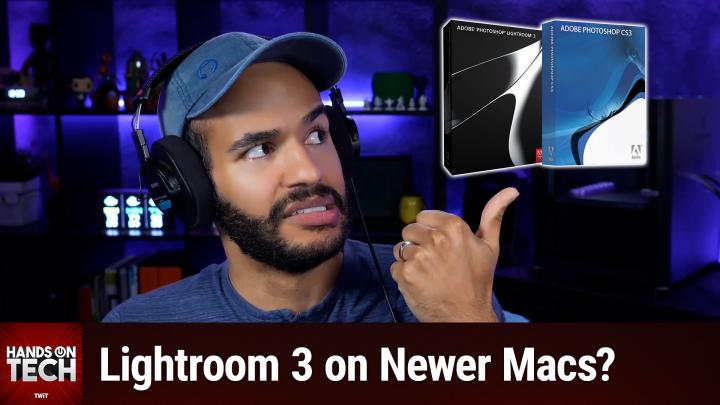
·S3 E227
Using Older Windows Software on a Modern Mac - Running CS3 and Lightroom 3 on Newer Macs?
Episode Transcript
Can You Install Windows Software on Your New MacBook? Here's What You Need to Know
Aug 5th 2025
AI-created, human-reviewed.
Making the leap from Windows to Mac often comes with an unexpected challenge: what to do with the software you've invested in over the years. This scenario recently came up on Hands-On Tech when a listener named Joe asked about running his Windows copies of Adobe Lightroom 3 and Photoshop CS3 on his new MacBook Air M4.
The question touches on a common dilemma that many users face when switching platforms. As Mikah Sargent explained on the show, "I understand wanting to be able to use the software that you've purchased, that you own, that you paid for." However, the reality of cross-platform compatibility, especially with older software, presents several technical hurdles.
The Architecture Challenge
The most fundamental issue stems from hardware architecture differences. Modern MacBooks, particularly those with Apple's M-series chips, use ARM architecture, while older Windows software like CS3 was designed for x86 processors. This creates a compatibility gap that goes beyond simple operating system differences.
Sargent noted that these older programs are "from like 2007 or 2008, and therefore don't have the compatibility for the software you're trying to install." The age factor compounds the architecture problem, making virtualization solutions less reliable than they might be with newer software.
Virtualization: A Possible but Imperfect Solution
Despite the challenges, virtualization remains the most viable option for running Windows software on Mac. Two primary solutions exist for Mac users: Parallels Desktop and VMware Fusion. Both allow you to run Windows as a virtual machine on your Mac, essentially creating a Windows environment within macOS.
However, as Sargent cautioned, "the performance of these applications is going to be reduced because you are virtualizing the experience." The performance impact becomes even more pronounced with graphics-intensive applications like Photoshop, where the lack of proper graphics acceleration can make the software nearly unusable.
For legacy software specifically, compatibility issues often prove insurmountable. Even if you successfully install Windows on ARM through virtualization, older x86 software may not run correctly or at all.
Alternative Approaches
Before abandoning hope entirely, there are a few strategies worth exploring. One potentially overlooked option involves contacting Adobe directly about license transfers. While not guaranteed, some software companies will allow users to transfer licenses between platforms, especially for discontinued products.
As Sargent suggested, "you could see if Adobe would let you use the Mac versions of these programs." However, he emphasized the importance of obtaining software only through official channels: "under no circumstances should you go to a random website that says it's got Lightroom and Photoshop CS3 and download them from there."
The Modern Alternative: Embrace Current Solutions
Rather than fighting compatibility issues, many users find success in transitioning to modern alternatives. The Adobe Creative Cloud subscription model, while representing a shift from one-time purchases, offers several advantages for Mac users.
Sargent, speaking from personal experience, shared: "I have a Creative Cloud subscription and it's one of my longest subscriptions that I have. And I have yet to regret having my Creative Cloud subscription." The subscription model ensures compatibility with new hardware and provides access to the latest features and improvements.
For users resistant to subscription models, several one-time purchase alternatives exist. Applications like Luminar Neo, Capture One, and Affinity Photo provide professional-grade photo editing capabilities without ongoing fees. Free options like GIMP offer basic editing functionality for users with simpler needs.
Practical Recommendations
The most practical approach often involves a hybrid strategy. Keep your existing Windows machine operational for legacy software while gradually transitioning to modern alternatives on your new Mac. This allows you to maintain your current workflow while exploring new tools at your own pace.
Many modern photo editing applications offer free trials, making it easier to evaluate whether they meet your specific needs. This trial period can help determine if the learning curve and feature differences are acceptable trade-offs for improved compatibility and performance.
The Bottom Line
While the desire to maintain continuity with familiar software is understandable, the technical realities of cross-platform compatibility often make this challenging. The combination of operating system differences, hardware architecture changes, and software age creates multiple barriers to seamless migration.
As Sargent concluded, "I don't think you are going to be able to get the exact experience that you want of just installing these and having them work on a modern Mac." However, this doesn't mean you're without options. Whether through virtualization experiments, license transfer requests, or transitioning to modern alternatives, several paths can help bridge the gap between your legacy software investment and your new hardware.
The key is approaching the transition with realistic expectations and openness to new solutions. While change can be challenging, modern software often provides capabilities that far exceed what was available in 2007-2008, potentially improving your workflow in ways you hadn't anticipated.
For users facing similar challenges, the recommendation is clear: explore your options methodically, but don't let attachment to old software prevent you from fully utilizing your new hardware's capabilities.